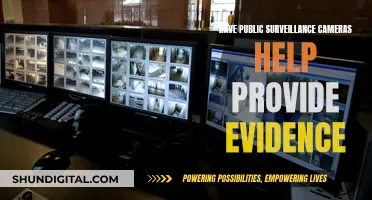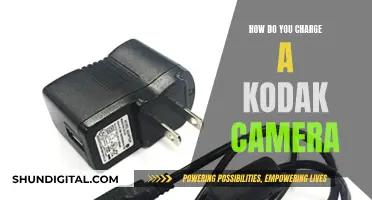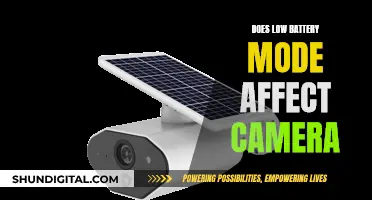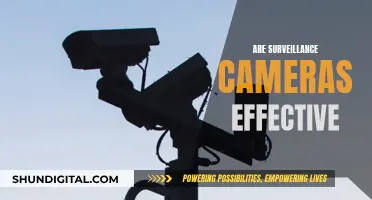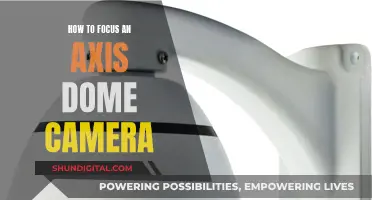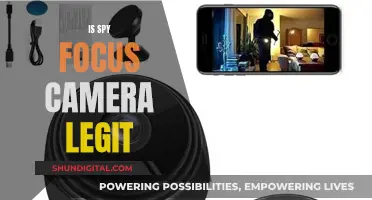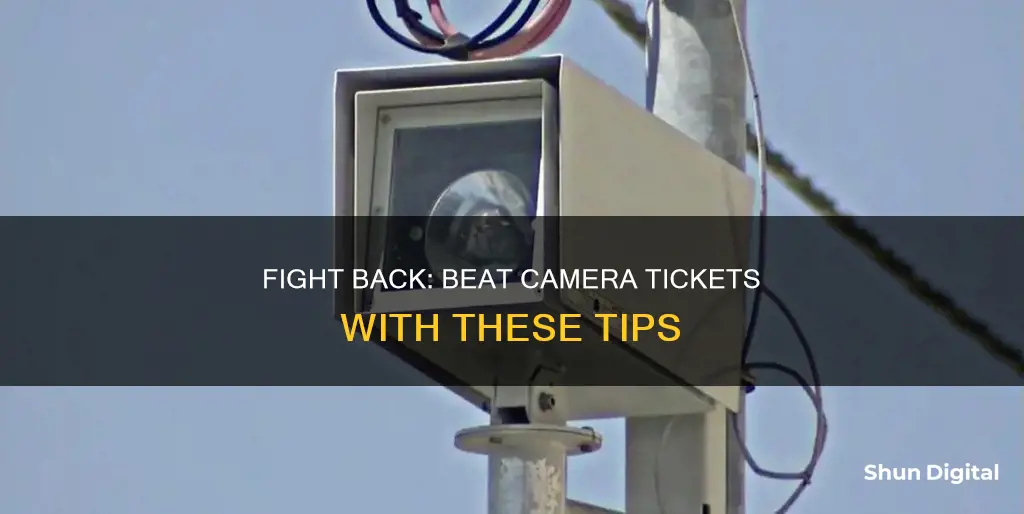
Getting a ticket from a traffic camera can be frustrating, but there are ways to fight it. Disputing a traffic camera ticket may be easier than you think, as traffic cameras are controversial in many jurisdictions. For example, red-light camera tickets in LA County can be ignored without penalty. If you want to fight a traffic camera ticket, you'll need to examine your ticket, plead not guilty, and make your defence.
| Characteristics | Values |
|---|---|
| Check ticket details | Check the date, time, and location of the ticket. Confirm you were driving the car when the ticket was issued. |
| Understand the violation | Make note of the exact code section you're cited for violating. Read the law to understand the elements and penalties for violation. |
| Review evidence | Examine any photos included with the ticket. Check for clarity and confirm it is your car in the photo. |
| Plead not guilty | Plead by mail, online, or in person at an arraignment. Do not pay the fine, as this may be considered an admission of guilt. |
| Request documents | Obtain copies of photos, camera maintenance records, and traffic light/speed monitoring system records. |
| Research applicable law | Look for cases in your city or county about traffic cameras and their legality. Identify potential defenses, such as warning sign requirements or necessity defenses. |
| Prepare your defense | Organize your documents and present yourself professionally in court. Treat courthouse staff with respect. |
| Challenge evidence | Dispute the admissibility of photographs as hearsay. Assert your right to confront witnesses and challenge the authenticity of the evidence. |
| Attack lack of evidence | Argue that the prosecution cannot prove you were driving or that the traffic light/speed detection system was functioning properly. |
| Examine photographs | Find any defects, inconsistencies, and defenses in the photographs. |
What You'll Learn

Examine your ticket
When you receive a camera ticket in the mail, it's important to examine it thoroughly before deciding on your next steps. Here are some key things to look out for when reviewing your ticket:
Check the Basics
First, confirm that all the information on the ticket is accurate and complete. Verify that your name and address are spelled correctly. This is important because fraud and identity theft are becoming more prevalent, and you want to ensure that the ticket is legitimate. Contact the agency that issued the ticket, such as the highway patrol or local police department, to verify its authenticity. Have your citation number ready when you call.
Understand the Arraignment Process
Note the date of your arraignment, which is when you'll enter a plea of guilty, not guilty, or guilty with explanation. This is not a court hearing where you present your case or evidence; it's simply an opportunity to enter your plea. If you plead guilty with an explanation, you're admitting guilt but asking the court to consider mitigating circumstances, which could lead to reduced penalties. Be sure to appear in court for your arraignment and identify yourself when your name and case are called.
Review the Ticket Details
Check the date, time, and location specified on the ticket. Camera tickets are typically sent to the owner of the car, so confirm that you were indeed driving the vehicle at that time and location. If someone else borrowed your car, you generally can't be prosecuted, but some states, like New York, treat red-light camera tickets as parking violations, holding the registered owner liable. Understand the specific laws in the jurisdiction where you received the ticket.
If you were driving, try to reconstruct the scene and write down any relevant details you remember. For example, you may have been making a legal right turn on a red light, which could be grounds for getting the ticket dismissed. Make note of the code section you're cited for violating, and ensure you understand the associated penalties. Remember, it's the prosecution's burden to prove each element of your violation, not your responsibility to prove your innocence.
Review the Photographs and Videos
If your ticket notification included photos or videos, review them carefully. Confirm that the vehicle in the media matches your car, and check if the license plate is clearly visible. Blurry or unclear photos can work in your favour, making it difficult to prove that the car is yours. Additionally, if there's no identifiable photo of you in the driver's seat, it may be challenging for the prosecution to prove that you were driving, especially if you live in a jurisdiction that requires tickets to follow the driver rather than the registered owner.
If photos or videos were not included with your citation, you may need to wait until after your trial is scheduled to request copies from law enforcement.
Partial Charging: Does It Damage Camera Batteries?
You may want to see also

Plead not guilty
If you want to dispute a traffic camera ticket, you must plead not guilty. Here are the steps you can take:
Some jurisdictions allow you to respond to the citation by mail or online for less serious traffic violations. Check your citation and make sure you plead not guilty before the deadline, which is typically within 30 days of receiving the ticket. If you have no option to plead by mail or online, you must appear at the arraignment listed on your citation and plead not guilty in person.
Request a Formal Hearing:
When you plead not guilty, demand a full formal hearing or trial. A formal hearing may require you to attend other hearings, such as pre-trial hearings or mediations, but don't accept anything less than a full dismissal of your traffic camera ticket.
Research Applicable Laws and Request Documents:
While waiting for your hearing, research the laws in your city or county regarding traffic cameras. Look for cases about traffic cameras and see if any appellate court decisions have ruled on the legality of traffic camera tickets. Additionally, call the local police department or law enforcement agency in charge of the camera and request full maintenance records and any photographs taken. These documents can help establish that the camera was regularly monitored, maintained, and functioning properly.
Present Your Defense at the Hearing:
Arrive at the courthouse on the day of your hearing with copies of any documents you intend to use as evidence. Treat the judge and courthouse staff with respect, and listen quietly while the prosecutor presents their case. During your defense, you can challenge the admissibility of the photograph as hearsay, dispute the authenticity of the photograph, or attack the lack of evidence. For example, argue that the prosecution cannot prove you were driving or that the traffic light was functioning properly.
Raise Other Possible Defenses:
If your challenge to the camera evidence is unsuccessful and the photos are admitted as evidence, you can still raise other possible defenses. For instance, some states recognize a necessity defense for speeding, allowing you to argue that you were speeding to avoid harm to yourself or others.
Exploring the HDF Mode S8 Camera
You may want to see also

Make your defence
On the day of your hearing, arrive at the courthouse with copies of any documents you intend to use as evidence in your defence. It is important to be well-prepared, organised, and to dress in a professional manner. Treat the judge and courthouse staff with respect and remain calm and polite throughout the proceedings.
Listen quietly as the prosecutor presents their case against you, making notes on anything you wish to address later. You can then begin to make your defence by challenging the admissibility of the photograph as hearsay. In some jurisdictions, a red light camera photo is considered hearsay, which is an out-of-court statement presented in court to prove the truth of the matter asserted.
You can also assert your right to confront witnesses, as the Sixth Amendment of the Constitution guarantees you the right to cross-examine them. Unless a witness appears who maintains the record and system associated with the camera, you do not have this opportunity.
Dispute the authenticity of the photograph by requesting that a representative from the company that maintains the camera shows up to testify. For the prosecution to rely on the photos as evidence, they must present proof that the camera, the system that connects it to the traffic light, and the traffic light itself were all functioning properly.
Finally, attack the lack of evidence. If the photos are clear and the judge allows them, but none of them clearly show you driving, you can argue that the prosecution cannot prove it was you driving the car. Additionally, the photo does not provide proof that the traffic light was functioning properly, meaning the prosecution cannot prove that you ran a red light.
Recycling Camera Batteries: Safe Disposal and Environmentally Friendly Options
You may want to see also

Request production of documents
If you want to fight a traffic camera ticket, you'll need to request a formal hearing and then ask for the production of documents. This is a legal process that requires the prosecutor to provide you with all the evidence that will be used against you in court.
To request the production of documents, you'll need to contact the local police department or the law enforcement agency responsible for the camera that issued your citation. Ask them for any photos that were not included with your citation, as well as the full maintenance records for the camera and any associated equipment, such as a traffic light or speed monitoring system. This will help you establish that the equipment was regularly monitored, maintained, and tested for accuracy. If it wasn't, the photo evidence may be unreliable.
In addition to requesting documents from the police, you should also serve a request for production on the prosecutor. This is a formal, written request that requires the prosecutor to provide a list of the evidence that will be used against you. If the prosecutor fails to respond to this request within the legally mandated time frame, you may be able to have your case dismissed.
The Intricate Process of Camera Drone Manufacturing
You may want to see also

Raise any other possible defences
If your attack on the camera evidence fails and the photos are admitted as evidence, you can still raise other possible defences.
Firstly, you could argue the defence of necessity, i.e., that you had no reasonable legal option other than to exceed the speed limit or run a red light. The burden of proof is on you to prove the defence of necessity. For example, you may have been rushing to the hospital in an emergency.
Another defence that might apply is if your vehicle was stolen, or if you were not the registered owner of the vehicle at the time the photograph was taken. These defences would only apply in very specific circumstances but they should be fairly straightforward to prove.
You can also carefully examine the evidence against you. You have a legal right to disclosure of the evidence. Is the licence plate partially obscured? Was the photo radar speed camera properly maintained? Was the conclusion reached by the reviewing officer based on sound reasoning? These are all possible avenues you or a trained legal representative can use to get a traffic ticket overturned.
You can also challenge the certificate evidence. A certificate is filed in court to indicate that the camera was functioning correctly, that the vehicle depicted was your vehicle, and that the information on the ticket is accurate. Certificate evidence is presumptively admissible but it has to comply with certain legal requirements, and there cannot be defects in the certificate. If you can prove that the evidence is wrong, or identify a flaw in the certificate, then you may have a defence.
Understanding Aperture Mode: Creative Control Over Your Camera
You may want to see also
Frequently asked questions
You can fight a camera ticket by examining the ticket, pleading not guilty, and making your defense. Check the date, time, and location of the ticket, and if you were the driver of the car at that time. Plead not guilty by mail, online, or in person, and demand a full formal hearing or trial. Research the applicable law and present your case in court.
One defense is to argue that the photograph is hearsay, which is an out-of-court statement presented in court to prove the truth of the matter asserted. In some jurisdictions, a red-light camera photo is considered hearsay. You can also assert your right to confront witnesses, as guaranteed by the Sixth Amendment of the Constitution. Additionally, you can dispute the authenticity of the photograph if no one from the company that maintains the camera testifies.
Examine the photographs carefully to find any defects, inconsistencies, or defenses. If the red light camera ticket is from L.A. County, you can simply ignore it without penalty. Make sure to check the red-light law in the jurisdiction where you got the ticket, as some states treat red-light camera tickets like parking violations, holding the registered owner liable.


